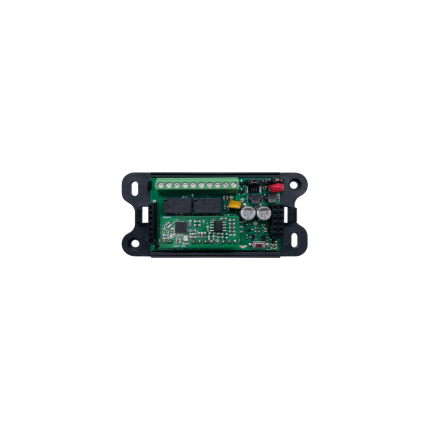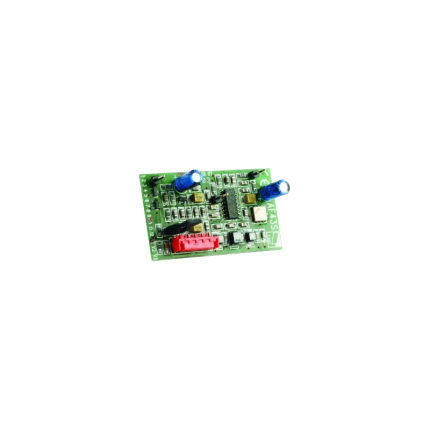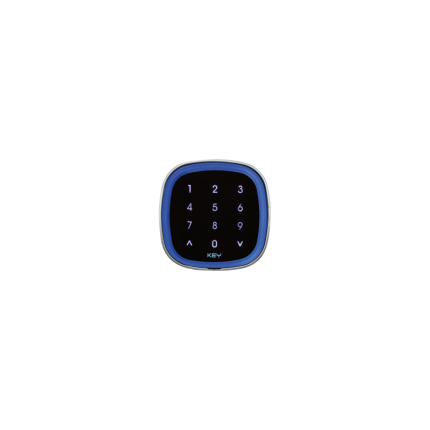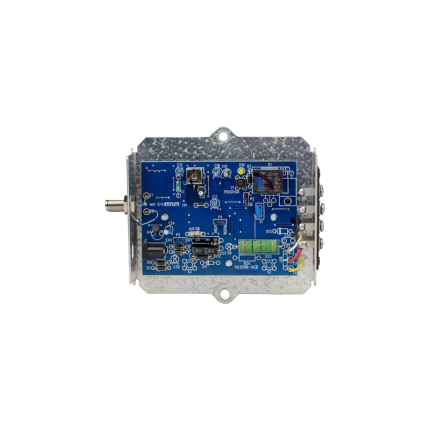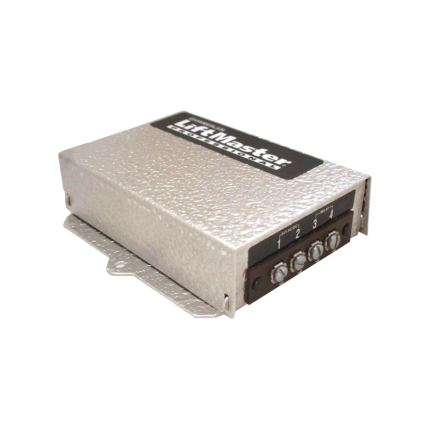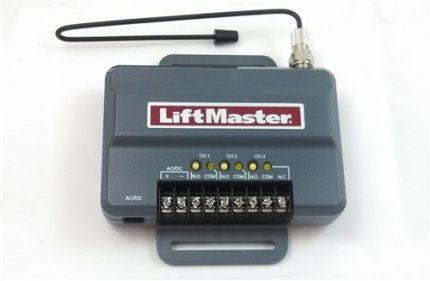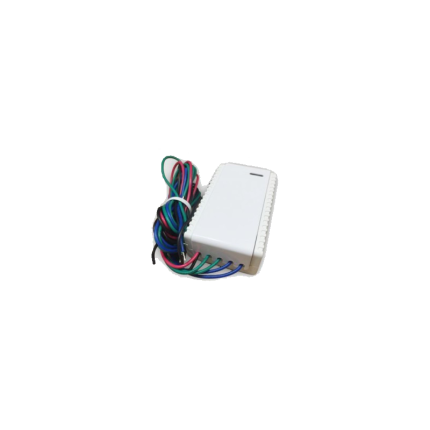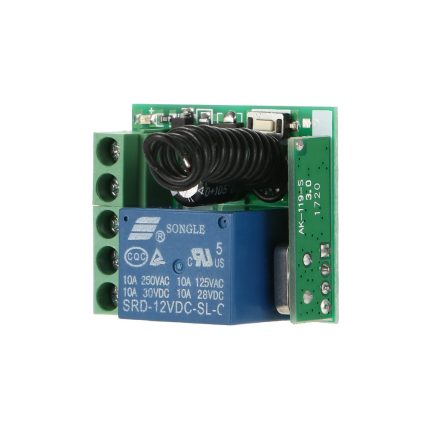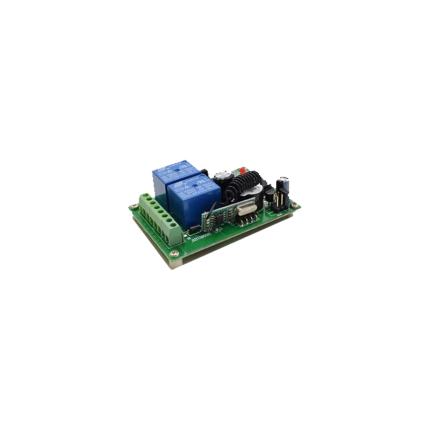receiver
BUS Encoder -Key Automation EGKD2
Ship or pick up from our office.
BUS Encoder -Key Automation EGKD2
PRODUCT SHEET PDFTECHNICAL FEATURES
| Force | N | 93 |
| Duty cycle percentage | % | 100% |
| Voltage | Vac | 10-24 |
| Voltage | Vdc | 12-34 |
| AC Voltage Frequency | Hz | 50/60 |
| Nominal power | W | 0,2 |
| Peak power | W | 23 |
| Appliance isolation class | III | |
| Degree of protection | IP | 30 |
| Dimensions (L - D - H) | mm | 88 - 41 - 25 |
| Item | kg | 0,109 |
| Minimum operating temperature | °C | -10 |
| Max operating temperature | °C | +55 |
Delay relay 0.5 Sec – AC 24 V to AC 24 V
Ship or pick up from our office.
Delay relay 0.5 Sec - AC 24 V to AC 24 V
delay relay 0.5 Sec - AC 24 V to AC 24 V is a type of electrical relay that introduces a 0.5-second time delay in a circuit, specifically designed to operate with a 24-volt AC (Alternating Current) power supply. This means that when the control voltage (24V AC) is applied or removed, the relay's output contacts won't change their state immediately; instead, there will be a half-second pause before they do. Here's a breakdown of what each part of the description means:- Delay Relay (or Time Delay Relay/Timer Relay): This is a control device that, unlike a standard relay, incorporates a timing function. It's used to control an event based on a pre-selected time interval.
- 0.5 Sec: This specifies the duration of the time delay. In this case, it's a very short half-second delay. Time delays can range from milliseconds to hours or even days, depending on the relay.
- AC 24 V (Input/Control Voltage): This indicates the type and voltage of the power supply required to energize the relay's coil or internal control circuitry. "AC" means Alternating Current, and "24 V" is the nominal voltage.
- to AC 24 V (Output/Load Voltage): While not explicitly stated as "output," this implies that the relay is likely intended to switch a 24V AC load. This means the contacts within the relay are rated to handle 24V AC to control another part of the circuit or a device. It's important to note that the load voltage can sometimes be different from the control voltage, but in this specific phrasing, it suggests both are 24V AC.
- On-Delay (Normally-Open, Timed-Closed - NOTC): The most common type. When the control voltage is applied, the timing period begins. After 0.5 seconds, the output contacts close. The contacts remain closed as long as the control voltage is present.
- Off-Delay (Normally-Open, Timed-Open - NOTO): When the control voltage is applied, the output contacts close immediately. When the control voltage is removed, the 0.5-second delay begins. After this delay, the contacts open.
- One-Shot: Provides a single output pulse of a specified duration (in this case, 0.5 seconds) when triggered.
- Repeat Cycle: Alternates between ON and OFF states for defined durations, creating a repeating cycle. This particular relay with a fixed 0.5-second delay is less likely to be a multi-function repeat cycle unless it's just one setting within a programmable unit.
- Sequencing Operations: Ensuring one component starts or stops slightly after another in a controlled sequence.
- Motor Control: Providing a brief delay before starting a motor (e.g., for pre-lubrication pumps to stabilize).
- Safety Interlocks: Implementing a short delay to ensure certain conditions are met before an action can occur.
- HVAC Systems: Timing the activation or deactivation of fans, compressors, or other components.
- Conveyor Systems: Coordinating the starting or stopping of multiple conveyor belts to prevent material jams.
- Lighting Control: For example, a short delay before turning on a light in a specific area
Gate Opener Remote Control 1400FT315
Ship or pick up from our office.
Gate Opener Remote Control 1400FT315
*High-Range 1400ft *315 MHz *Compatible with HomeLink system on vehicles *1 channelKeypad access control -Key Automation EGKTB1
PRODUCT SHEET PDF
While a specific image of the EGKTB1 is not available in the search results, the description aligns with the typical features and functionality of a keypad used for access control. You can likely find images of similar keypads by searching for "Keypad Access Control" or "Keypad Security System".
Keypad access control -Key Automation EGKTB1
*BUS decoder powered *Rain Shield Cover Included *Touch *Protection degree: IP 55 *BacklightTECHNICAL FEATURES
| Duty cycle percentage | % | 100% |
| Voltage | Vac | 10-24 |
| Voltage | Vdc | 12-34 |
| AC Voltage Frequency | Hz | 50/60 |
| Nominal power | W | 0,25 |
| Peak power | W | 1,5 |
| Appliance isolation class | III | |
| Degree of protection | IP | 55 |
| Dimensions (L - D - H) | mm | 79 - 23 - 79 |
| Item | kg | 0,25 |
| Minimum operating temperature | °C | -10 |
| Max operating temperature | °C | +55 |
The Keypad Key Automation EGKTB1 is a keypad used for access control.
It's a type of electronic keypad that likely integrates with a security system to allow entry based on a code or combination.
Keypads like the EGKTB1 typically replace traditional keys and locks, providing a more secure and convenient way to manage access to a building or specific areas within a building.
Here's a more detailed explanation:
-
Access Control:The primary function of the EGKTB1 is to control access to a secured area.
-
Keypad Functionality:It allows users to enter a pre-set code using the keypad's buttons. This code is then verified by the connected security system.
-
Integration:It's designed to connect with a security system or control unit, often using a Wiegand protocol, to manage access permissions.
-
Security:Keypads offer a more secure alternative to traditional keys because they can be reprogrammed with new codes, and they eliminate the need to physically distribute keys.
-
Convenience:Keypads offer a convenient way to manage access, especially in situations where there are many users or frequent changes in access needs.
Radio receiver – LiftMaster 312HM
Ship or pick up from our office.
Radio receiver – LiftMaster 312HM
A LiftMaster radio receiver is a device that allows LiftMaster garage door openers, gate operators, and other access control systems to communicate wirelessly with remote controls or keypads. These receivers are crucial for enabling remote operation of devices and are often used in both residential and commercial settings.
Here's a more detailed explanation:
-
Functionality:LiftMaster radio receivers act as a bridge, translating the signals from a remote control or keypad into commands that the opener or operator can understand and execute.
-
Types:There are various types of LiftMaster receivers, including those designed for garage door openers, gate operators, and commercial door operators.
-
Security:Many LiftMaster receivers, especially those with Security+ 2.0 technology, use rolling code encryption to enhance security and prevent unauthorized access.
-
Compatibility:LiftMaster receivers are designed to be compatible with a range of LiftMaster remote controls and keypads.
-
Installation:Receivers can be internal (built into the opener or operator) or external (connected via wiring to the opener or operator).
-
Features:Some receivers offer features like multi-channel support (allowing control of multiple devices), narrow-band technology (to minimize interference), and the ability to temporarily disable remotes.
-
Examples:
- 850LM: A universal receiver compatible with Security+ 2.0 remotes, often used in gated communities and for controlling multiple access points.
- 412HM: A 390MHz Liftmaster radio receiver commonly used with gate operators and commercial doors.
- STAR1000: A commercial receiver with advanced features like user management and copying remote settings.
- 850LM: A universal receiver compatible with Security+ 2.0 remotes, often used in gated communities and for controlling multiple access points.
Radio receiver – LiftMaster 412HM
Ship or pick up from our office.
Radio receiver – LiftMaster 412HM
How it Works:
- The receiver is installed on the gate or garage door opener's control board.
- It receives signals from the remote control.
- The receiver then transmits the signal to the opener's control board.
- The control board verifies the signal and activates the door or gate.
In essence, the 412HM allows you to control your gate or garage door with a LiftMaster remote, offering a secure and convenient access solution.
Radio receiver – LiftMaster 850LM – 3 Channels
Ship or pick up from our office.
Radio receiver – LiftMaster 850LM – 3 Channels
Universal Radio Receiver LiftMaster 850LM is used for garage doors and driveway gate operators.
- Universal Radio Receiver Liftmaster 850LM is suitable for residential and commercial sliding gates and swing driveway gates.
- Security Encrypted Code For Extra Dependability.
- Manage Multiple Access Points With A Single LiftMaster Radio Receiver.
- 3 channels for control of 3 driveway gate openers.
Radio receiver R5130
Ship or pick up from our office.
Radio receiver R5130
(Compatible with the wireless keypad control KW125) *AC/DC 12-24 V *2 Channels *433.92 MHzRadio receiver RECT102-V2.0 – CH2
Ship or pick up from our office.
Radio receiver RECT102-V2.0 - CH2
(Compatible with the wireless keypad control KW402 & KW125) *AC/DC 12-24 V *2-CH *433.92 MHz *Capacity: 2000 remotesRadio receiver RG315-12V1C
Ship or pick up from our office.
Radio receiver RG315-12V1C
* DC 12 V * 1 Channel * 315 MHz * Compatible with the Homelink system The RG315-12V1C is a radio receiver designed for automatic gate operators and garage doors. 🚧 It operates at a frequency of 315 MHz and is compatible with a wide range of gate operators, including Italian, Chinese, swing gate, sliding gate, and overhead garage door systems. Key Features- Operating Frequency: 315 MHz
- Voltage: 12V DC
- Compatibility: Works with various gate operators and garage doors.
- Capacity: Can store up to 100 remote controls.
- Signal Penetration: Its wireless RF signals can effectively pass through walls, floors, doors, and windows.
- Design: It's compact, lightweight, portable, and easy to install.
- Multiple Units: Multiple RG315-12V1C units can be used in the same location without interference.
- Gate Openers: Allowing remote control of swing gates and sliding gates.
- Garage Door Openers: Enabling wireless operation of overhead garage doors.
Radio receiver RG315-12V2C
Ship or pick up from our office.
Radio receiver RG315-12V2C
*DC 12 V *2-CH *315 MHz * Compatible with Homelink systemRadio receiver RG315-24V1C
Ship or pick up from our office.
Radio receiver RG315-24V1C
*DC 24 V *1 Channel *315 MHz * Compatible with the Homelink system A gate opener radio receiver is an electronic device that acts as the "ear" for an automatic gate system. Its primary function is to receive radio signals from a remote control (transmitter) and, upon recognizing a valid signal, instruct the gate opener's control board to activate the gate motor to open or close the gate. How it Works Here's a breakdown of how a gate opener radio receiver typically operates:- Signal Reception: When you press a button on your remote control, it sends out a radio signal at a specific frequency (e.g., 300MHz, 310MHz, 318MHz, 433MHz).
- Compatibility: The receiver is tuned to the same frequency as the remote control. For the system to work, the receiver and remote must also be compatible in terms of brand and radio protocol (e.g., rolling code, fixed code).
- Decoding: The receiver decodes the radio signal it receives. Modern systems often use "rolling code" technology for enhanced security, where the code changes with each use, making it very difficult for unauthorized individuals to duplicate or intercept.
- Command Relay: Once the signal is decoded and validated, the receiver relays the command to the gate opener's main control board.
- Gate Activation: The control board then triggers the gate motor, causing the gate to open or close.
- Internal vs. External: Some gate openers have built-in receivers, while others utilize external receivers that connect to the system. External receivers can be used as replacements if an internal one fails or to add functionality.
- Channels: Receivers can be single-channel (controlling one gate) or multi-channel (controlling multiple gates or other devices).
- Frequency: Receivers operate on specific radio frequencies, and it's crucial that the remote control matches the receiver's frequency.
- Security: Newer receivers often incorporate advanced security features like rolling codes or encrypted protocols to prevent unauthorized access.
- Range: The effective range of a receiver varies, typically from 50 to 100 feet, but some long-range receivers can extend this distance.
- Power Input: Receivers can operate on various voltages, such as 12V DC, 24V DC, or even 110V AC, depending on the gate opener system.
- Compatibility: While some receivers are universal, many are designed to work with specific brands or types of remote controls.
- Convenience: It allows users to open and close gates remotely, eliminating the need to manually operate them.
- Security: With coded and encrypted signals, it ensures that only authorized individuals can access the property.
- Flexibility: Many receivers can be programmed to work with multiple remote controls, accommodating various users.

